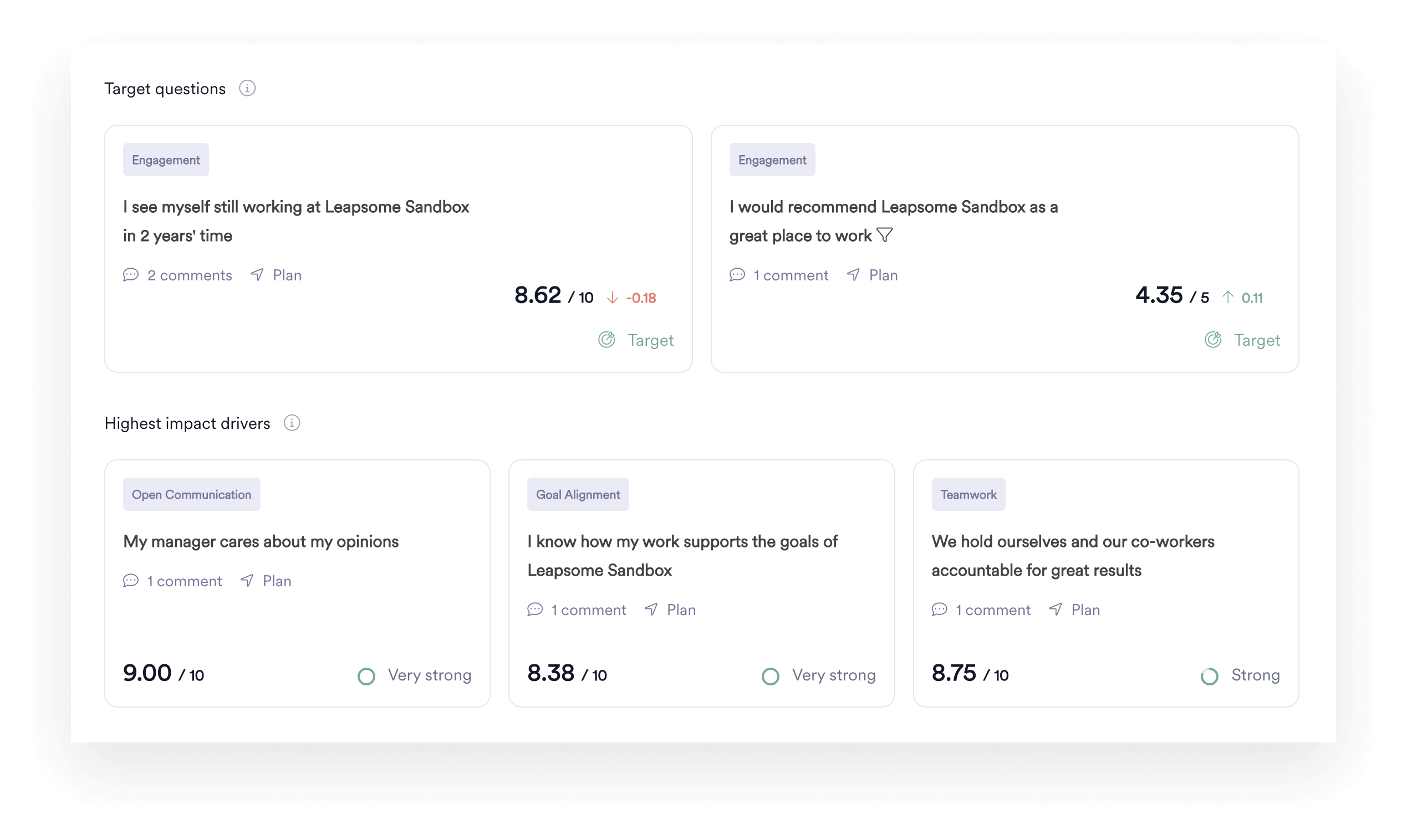.png)
TL; DR: Das Engagement der Mitarbeiter hängt eng mit Leistung, Produktivität und Rentabilität zusammen. Das bedeutet, dass Sie die potenziellen Auswirkungen der Umfrageergebnisse zur Mitarbeitermotivation auf eine erfolgreiche Personalstrategie nicht übersehen sollten. Ohne einen soliden Aktionsplan kann es jedoch schwierig sein, Ihren Kollegen (und Geschäftsführern) zu zeigen, dass eine Umfrage zum Mitarbeiterengagement mehr als eine obligatorische Übung ist. Mit den richtigen Prozessen, Stakeholdern und Tools können Ihre Umfrageergebnisse spürbare unternehmensweite Vorteile bringen, selbst wenn das Mitarbeiterengagement weltweit abnimmt.
Die Ergebnisse der Umfrage zum Mitarbeiterengagement sind die quantitativen und qualitativen Daten, die Sie nach der Durchführung einer Umfrage zum Mitarbeiterengagement erhalten. Sie unterstützen jede Personalstrategie, bei der Mitarbeiter im Mittelpunkt stehen, indem sie es Managern und Mitarbeitern von People Ops ermöglichen, zu verstehen, wie Teammitglieder bei der Arbeit denken, fühlen und sich verhalten.
Wenn Sie mindestens vierteljährlich Umfragen zum Engagement durchführen, ist es einfacher, Trends zu erkennen, das Engagement der Mitarbeiter vorherzusagen und Maßnahmen in Echtzeit zu ergreifen.
Es gab keinen kritischeren Zeitpunkt für die Priorisierung von Daten zum Mitarbeiterengagement als jetzt. Das Engagement der Mitarbeiter hat gerade zugeschlagen ein 11-Jahres-Tief in den USA, und das versunkene Engagement kostet die Weltwirtschaft jährlich geschätzte 9 Billionen US-Dollar. Während die USA gerade eine vermieden haben große wirtschaftliche Rezession, die daraus resultierenden Marktturbulenzen haben sich darauf ausgewirkt, wie die Mitarbeiter über ihre Arbeit denken.
Ob Sie sich dessen bewusst sind oder nicht, das Engagement Ihrer Mitarbeiter wirkt sich auf fast jeden Bereich Ihres Unternehmens aus. Laut Gallups Q12® -Metaanalyse 2024, das Niveau des Engagements steht in direktem Zusammenhang mit der Geschäftsleistung. Der Bericht weist auf starke Korrelationen zwischen Mitarbeiterengagement und Leistungskennzahlen wie Wohlbefinden, Sicherheit, Fehlzeiten, Arbeitsqualität, Kundenbindung und Produktivität hin.
Was ist mehr, Geschäftsbereiche mit hohem Engagement verlieren 43% weniger Mitarbeiter. Durch die Reduzierung der Fluktuation werden Unternehmen effizienter. Fluktuationskosten können sich schnell summieren, da neue Teammitglieder geschult werden müssen. Die Society for Human Resource Management (SHRM) schätzt, dass Mitarbeiterfluktuation bis zu ein Drittel des Jahresgehalts des ausscheidenden Mitarbeiters. Andere Studien deuten auf ein noch düsteres Szenario hin: Der Austausch einer Person könnte Sie etwas kosten bis zum Zweifachen ihres Jahreslohns.
Wenn man bedenkt, wie sich Mitarbeiterengagement auf Fluktuation und Leistung auswirkt, ist es keine Überraschung, dass sich so viele Unternehmen dafür entscheiden, diese Kennzahl mithilfe von Umfragen zu verfolgen. Dennoch reicht es nicht aus, nur Lauf Umfragen zum Engagement: Sie müssen auch die Informationen verwenden, die Sie sammeln.
Die Analyse der Umfrage zum Mitarbeiterengagement ist entscheidend, um bessere Geschäftsergebnisse zu erzielen und das Vertrauen der Teammitglieder aufzubauen. Mitarbeiter wissen es zu schätzen, wenn ihre Anliegen gehört werden. Diejenigen, die sich gehört fühlen, tun es fast fünfmal wahrscheinlicher um sich befähigt zu fühlen, ihr Bestes zu geben. Umgekehrt kann es schnell zu Engagementproblemen kommen, wenn sich Teammitglieder nicht gehört fühlen: 64% der Fachkräfte sagen, dass „Führungskräfte, die Entscheidungen treffen, ohne ihren Beitrag einzuholen“, ihr größtes Problem bei der Arbeit ist.
Durch die Nutzung der Daten aus Mitarbeiterbefragungen steigt auch die Bereitschaft der Teammitglieder, an zukünftigen Umfragen teilzunehmen. Laut McKinsey-Recherchen, die Hauptursache für „Umfragemüdigkeit“ ist die Wahrnehmung, dass Unternehmen nicht auf die Ergebnisse reagieren werden.
„Führung ist das größte Hindernis, wenn es darum geht, Umfrageergebnisse in die Tat umzusetzen. Die Umsetzung von Veränderungen erfordert nicht viel Geld, aber es erfordert Zeit und Engagement. Die Umfrage durchzuführen ist der einfache Teil, aber bereit zu sein, das Feedback zu verinnerlichen und es in die Tat umzusetzen, ist aus irgendeinem Grund für einige Organisationen fast unmöglich.
Vor der Veröffentlichung der Umfrage müssen sich die Führungskräfte untereinander und gegenüber ihren Mitarbeitern verpflichten, dass die Umfrage nicht nur ein Haufen Gerede ist, sondern zu tatsächlichen Veränderungen führt.“
— Catharine Montgomery, Kommunikationsleiter für soziale Zwecke, spricht über die Macht von Umfragen zur Vielfalt
Also, wie nutzt man Umfrageergebnisse und nutzt sie, um das Engagement zu steigern? Lesen Sie weiter, um zu erfahren, wie Sie das Beste aus Ihren Mitarbeiterbefragungen herausholen können.
💡 Analysieren Sie Umfrageergebnisse schneller mit Leapsome AI
Mit den KI-gestützten Umfragen von Leapsome können Sie Umfrageergebnisse schnell zusammenfassen, wichtige Themen extrahieren und sogar Handlungsempfehlungen generieren.
👉 Erfahren Sie, was Leapsome Surveys für Sie tun kann

Sie können damit beginnen, auf die Ergebnisse der Umfrage zum Mitarbeiterengagement zu reagieren, sobald Sie sie erhalten. Sie sollten dieses Playbook verwenden, wenn Sie kürzlich eine Umfrage zum Mitarbeiterengagement, haben Pulsumfrage Daten, die Sie im Laufe der Zeit aggregiert haben oder die Sie beabsichtigen, mit der Durchführung von Umfragen zu beginnen.
Die Auswertung der Ergebnisse einer Umfrage zur Kundenbindung kann Ihnen helfen, unmittelbare Probleme zu lösen und langfristige Trends zu erkennen. Mit anderen Worten, die Messung des Engagements ermöglicht es Ihnen, aktuelle Probleme zu lokalisieren und Veränderungen des unternehmensweiten Engagements von Jahr zu Jahr zu erkennen.
Um dieses Playbook ausführen zu können, benötigen Sie ein Mitarbeiterbefragungsprogramm, um Daten zu sammeln.
Wenn Sie noch keinen Prozess für die Durchführung von Umfragen haben oder wenn Sie der Meinung sind, dass Ihr bestehendes Programm verbessert werden könnte, lesen Sie unser Playbook unter Durchführung einer Umfrage zum Mitarbeiterengagement für hilfreiche Tipps für den Einstieg.
Ihr Umfrageprogramm sollte eine Reihe definierter Ziele haben. Warum leiten Sie Employee Umfragen zum Engagement? Was erhoffst du dir von ihnen?
Auf diese Weise können Sie besser verstehen, wie Sie auf die Umfragen reagieren müssen und auf welche Ergebnisse Sie hinarbeiten sollten.

Bevor Sie damit beginnen können, die Ergebnisse Ihrer Mitarbeiterumfragen in die Tat umzusetzen, müssen Sie Ihre Umfragen verwalten.
Die meisten Personalabteilungen Umfragen durchführen häufig. Sie könnten sie wöchentlich, monatlich oder vierteljährlich versenden. Um eine Übermüdung der Umfrage zu vermeiden, sollten Sie versuchen, Länge und Häufigkeit der Umfrage in ein ausgewogenes Verhältnis zu bringen. Je seltener die Umfrage ist, desto mehr Fragen können Sie einbeziehen und umgekehrt.
Stellen Sie sicher, dass die Mitarbeiter wissen, wann sie mit einer Umfrage rechnen können, und erinnern Sie sie daran, sie auszufüllen, um eine höhere Abschlussrate zu erzielen.
Denken Sie daran: Der stärkste Motivator für die Mitarbeiterbeteiligung ist eine Kultur, in der auf die Ergebnisse von Mitarbeiterbefragungen reagiert wird. Ganz gleich, wie viele Erinnerungen Sie verschicken, niemand möchte Zeit damit verbringen, eine Umfrage auszufüllen, wenn er glaubt, dass die Ergebnisse ignoriert werden.
Wie führen Sie derzeit Umfragen zum Mitarbeiterengagement durch? Verwenden Sie eine Mischung aus Software und Dokumenten oder führen Sie Umfragen sogar auf Papier durch? Wenn die Ergebnisse von Mitarbeiterbefragungen an verschiedenen Stellen verstreut sind, kann dies zu Verwirrung führen und die Analyse der gesammelten Daten erschweren.
Um den Überblick zu behalten und die Analyse des Mitarbeiterengagements zu beschleunigen, ist es hilfreich, eine „zentrale Informationsquelle“ für die Ergebnisse Ihrer Mitarbeiterumfragen zu haben. Mit einer Personalmanagement-Plattform können Sie Ihren Umfrageprozess an einem Ort verwalten — neben anderen wichtigen HR-Funktionen wie Leistungsmanagement, OKRs und Lernen.
💡Suchen Sie nach einer Umfrageplattform, die Ihnen sagt, welche Maßnahmen Sie ergreifen müssen?
Leapsome generiert personalisierte Empfehlungen auf der Grundlage der Ergebnisse Ihrer Engagement-Umfrage, sodass Sie die richtige Strategie für Ihr Unternehmen entwickeln können.
👉Entdecken Sie, wie Leapsome Surveys Ihnen helfen können

In der Analyse Ihrer Mitarbeiterbefragung haben Sie Zugriff auf zwei Arten von Daten: quantitative und qualitative. Quantitative Daten können durch Zahlen oder Kennzahlen ausgedrückt werden, während qualitative Daten eher aus subjektiven, ausführlichen Antworten bestehen.
Das Net Promoter Score (eNPS) für Mitarbeiter ist eine häufig verfolgte quantitative Metrik. Der Net Promoter Score ist eine weit verbreitete Kennzahl zur Erfassung der Kundenzufriedenheit, und eNPS wendet dieselbe Kennzahl für die Mitarbeiterzufriedenheit an.
Sie können Ihre eNPs anhand einer einzigen Umfragefrage ermitteln: „Wie wahrscheinlich ist es auf einer Skala von 0—10, dass Sie unsere Organisation einem Freund oder Kollegen empfehlen würden?“ Mitarbeiter können wie folgt eingestuft werden Kritiker (0—6), Passive (7—8), oder Promotoren (9—10), abhängig von den Punktzahlen, die sie geben. Um Ihren eNPS-Score zu berechnen, ziehen Sie den Prozentsatz der Kritiker vom Prozentsatz der Befürworter ab. Mit den Analysen der Mitarbeiterumfragen von Leapsome können Sie den eNPS auch ganz einfach messen.
Um Ihre quantitativen Daten besser zu verstehen, versuchen Sie, sie zu filtern und zu segmentieren — zum Beispiel nach Alter, Geschlecht, Team oder Berufsbezeichnung. Mit Leapsome können Sie auch die Benchmarks anderer Unternehmen überprüfen.

Qualitative Daten sind etwas komplexer zu analysieren. Wenn Sie sich die ausführliche Antwort einer Person ansehen, sind Sie sich möglicherweise nicht sicher, was sie mit ihren Kommentaren meint. Sie könnten sie zwar bitten, dies in einem persönlichen Gespräch näher zu erläutern, bei anonymen Umfragen kann dies jedoch schwierig sein.
Zum Glück können Sie mit Leapsome ganz einfach die Befragten der Mitarbeiterbefragung kontaktieren und anonyme Gespräche führen.
Die Stimmungsanalyse kann Ihnen auch dabei helfen, qualitative Daten in großem Maßstab zu analysieren. Diese Technik der natürlichen Sprachverarbeitung (NLP) (die Sie in Leapsome finden!) kann dir helfen, Informationen zu verdauen und zu visualisieren, indem du Kommentare in Kategorien gruppierst und sie als positiv, negativ oder neutral klassifizierst.
Der nächste Schritt besteht darin, sich das „Gesamtbild“ Ihrer Engagement-Umfrageergebnisse anzusehen. Ihre qualitativen und quantitativen Analysen sollten wichtige Punkte aufgedeckt haben, auf die Sie sich konzentrieren sollten. Sobald Sie die Stärken und Schwächen Ihres Unternehmens identifiziert haben, überlegen Sie, wie sich diese in einen Aktionsplan umsetzen lassen könnten.
Wenn beispielsweise die meisten Mitarbeiter bei der Aussage „Mein Manager interessiert sich für meine Meinung“ niedrige Punktzahlen abgegeben haben, könnten Sie erwägen, ein Schulungsprogramm für Führungskräfte einzurichten. Oder wenn die Aussage „Ich habe Zugriff auf die Ausrüstung und Werkzeuge, die ich für meine Arbeit benötige“ schlecht bewertet wurde, ist es vielleicht an der Zeit, Ihre Technologie und Infrastruktur zu modernisieren.
Die Ideen, die Sie während dieses Brainstormings entwickeln, dienen als Grundlage für Ihren Aktionsplan.

Es ist an der Zeit, einen Aktionsplan zu erstellen und zu entscheiden, wie es weitergehen soll. Hier wählen Sie die wichtigsten Punkte aus, auf die Sie sich konzentrieren möchten, und skizzieren die spezifischen Schritte, die Sie unternehmen werden, um Ihre Ziele zu erreichen.
Legen Sie Ihren Aktionsplan schriftlich fest und legen Sie regelmäßige Kontrollpunkte und Fristen für die Rechenschaftspflicht fest. Mit Leapsome können Sie diese Art von Plan nach der Umfrage erstellen und die Verantwortung für bestimmte Projekte zuweisen, sodass Sie Ihre Fortschritte ganz einfach verfolgen können.
Vermeiden Sie es, einfach Dekrete von oben zu erlassen, um Mitarbeiter auf allen Unternehmensebenen zu engagieren und einzubeziehen. Erwägen Sie auch, Mitarbeitern Möglichkeiten zu bieten, Veränderungen von unten nach oben herbeizuführen. Beispielsweise haben viele Unternehmen Arbeitsgruppen eingerichtet, in denen Mitarbeiter DEI-Themen erörtern, Bedenken äußern und zukünftige Maßnahmen planen können.
Sobald Sie die Daten analysiert, verstanden und Ihren Aktionsplan erstellt haben, ist es an der Zeit, die Umfrageergebnisse mit den Mitarbeitern Ihres Unternehmens zu teilen.
Entscheiden Sie, wer die Umfrageergebnisse, Datenvisualisierungen und den Aktionsplan sehen muss — und wie sie präsentiert werden sollen. Die Ergebnisse von Mitarbeiterbefragungen sollten immer mit den Vorgesetzten besprochen werden, und wir empfehlen, dass Sie sie auch den Mitarbeitern mitteilen (insbesondere, wenn Sie große Änderungen planen).
Sie können die Ergebnisse der Mitarbeiterbefragung in einer Mitarbeiterbesprechung teilen und per E-Mail weiterverfolgen, wobei der Aktionsplan der vorherigen Runde und die Ergebnisse zusammengefasst werden.
„Machen Sie bei Ihrem Treffen mit allen Mitarbeitern eine AMA [Ask Me Anything] und holen Sie den Gründer dorthin, um strukturelle Veränderungen zu besprechen. Bringen Sie die Leute dazu, ihnen im Voraus Fragen zu stellen.
Seien Sie in der Lage, zu kommen und verwundbar zu sein in Bezug auf das, was Sie tun, woran Sie arbeiten und was diese Änderungen in der Praxis bedeuten werden und warum Sie sie für wichtig halten. Zeigen Sie, dass Sie sich wirklich darum kümmern.“
— Matthew Bradburn, Mitbegründer von Das Volkskollektivund bietet im Podcast People Over Perks seine Erkenntnisse darüber, wie auf die Ergebnisse der Umfrage zum Mitarbeiterengagement reagiert werden kann
Die Ergebnisse der Mitarbeiterbefragung sollten langfristig die Richtung Ihrer Unternehmenskultur bestimmen.
Wenn Sie Umfrageergebnisse in die Tat umsetzen, stoßen Sie möglicherweise auf Ziele, die Sie nicht sofort umsetzen können. Diese langfristigen Ziele sollten jedoch in das Gesamtkonzept Ihres Unternehmens integriert werden. OKRs oder Zielplanungsrahmen. Auf diese Weise können sich die Beteiligten gegenseitig dafür verantwortlich machen, dass Dinge geschehen.
⭐️ Sie wissen nicht, wo Sie mit Umfragen zum Mitarbeiterengagement beginnen sollen? Schau dir das an kostenlose Liste mit 72 Best-Practice-Fragen in 22 Kategorien, komplett mit einer Infografik und einer herunterladbaren Ressource, um die Sache noch einfacher zu machen. 😉
Ein herausforderndes Wirtschaftsklima sollte Sie nicht davon abhalten, in das Engagement Ihrer Mitarbeiter zu investieren — ganz im Gegenteil! In Zeiten wie diesen kann es schwierig sein, Mitarbeiter zur Teilnahme an Umfragen zu ermutigen, wenn sie an Untätigkeit gewöhnt sind. Aus diesem Grund bietet Leapsome Ihnen die Tools, mit denen Sie allen genau zeigen können, wie Sie ihr Feedback nutzen möchten.
Unser Unterstützung von Menschen Mit dieser Plattform können Sie einen gut durchdachten Umfragezyklus zum Engagement erstellen, der KI-gestützte Umfrageanalysen und umsetzbare Erkenntnisse darüber enthält, wie sich Ihre Mitarbeiter bei der Arbeit fühlen.
Sehen Sie sich dieses Video an, um zu erfahren, wie Leapsome Ihnen helfen kann, eine bessere Feedback-Schleife für Mitarbeiter aufzubauen.
💪 Machen Sie Ihre Engagement-Strategie mit KI-gestützten Umfragen zukunftssicher
Automatisieren Sie Ihren Umfragezyklus mit Leapsome und erhalten Sie Zugriff auf detaillierte Analysen und personalisierte Aktionspläne, damit Sie Ihre Strategie agiler umsetzen können.
👉 Eine Demo buchen

Denken Sie bei der Kommunikation der Ergebnisse von Mitarbeiterbefragungen daran, dass Ihre Mitarbeiter Transparenz schätzen. Wenn Sie größere Änderungen planen, ist es möglicherweise am besten, diese mit den Mitarbeitern in einer Besprechung zu besprechen, anstatt sie per E-Mail zu senden. Auf diese Weise können Mitarbeiter Fragen stellen, Feedback geben und etwaige Zweifel ausräumen.
Achten Sie beim Teilen von Ergebnissen darauf, Anonymität und Datenschutz zu respektieren. Vermeiden Sie es, detaillierte Kommentare zu teilen, die auf eine Person zurückgeführt werden könnten — insbesondere zu sensiblen Themen.
Zu führen Sie eine Umfrage zum Mitarbeiterengagement durch, definieren Sie zunächst Ihre Umfrageziele und entscheiden Sie, wer teilnehmen wird. Erstellen Sie dann Ihre Fragen zur Umfrage zum Mitarbeiterengagement. Versenden Sie die Umfrage abschließend in regelmäßigen Abständen gemäß Ihrem bevorzugten Zeitplan. Vergessen Sie nicht, Erinnerungen zu senden, um die Teilnahme zu fördern!
Erfahrt genau, wie unsere Plattform HR-Prozesse automatisiert, verknüpft und vereinfacht.
.webp)
.webp)
 Jetzt Demo buchen
Jetzt Demo buchen


Run smooth operations with our easy-to-follow how-tos and best practices for all things People Ops
Mit unseren leicht verständlichen Anleitungen und Best Practices für People Ops sorgen Sie für reibungslose Abläufe.